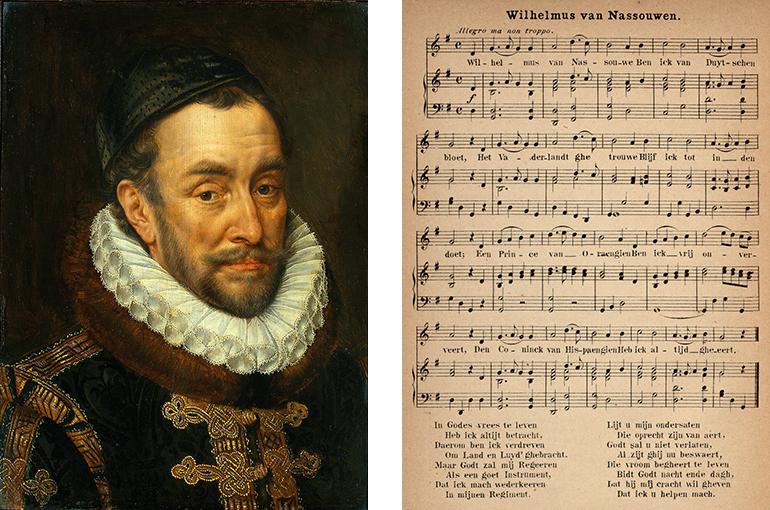By Albert van der HeideThe public farewell of Vancouver-based Consul General Gert Heijkoop of the Netherlands deserves a separate entry in the history annals of the Netherlands Association Je Maintiendrai and that of the local Dutch Canadian community. Mr. Heijkoop’s contribution to the recent 2018 King’s Day event at Canada Place location of De Dutch Pannekoek House, a quiz about national anthems, merits a follow-up for context in the columns of this electronic newsletter.For nearly a century now, the Dutch community in Vancouver will have joined in singing the first stanza of The William, in Dutch popularly known as ‘Het Wilhelmus’. It was a little different this year from earlier decades, since with the assistance of electronica, the lyrics of the lesser-known sixth stanza also ‘poured’ off the lips of a very enthusiastically participating crowd.It is one thing to join in singing the anthem, it is quite another to be spontaneously quizzed for answers about ‘Het Wilhelmus’ and its foreign equivalents. The crowd was impressive as it rose to Mr. Heijkoop’s challenges at his farewell event, a number of people earning prizes for the right response to difficult questions. In the comfort of your home now, would you know the answers to such as these? “Which is the oldest anthem in the world?” 1), “How many stanzas has the lengthiest anthem?” 2) and “How many stanzas has Het Wilhelmus?” 3)The story of Het Wilhelmus (van Nassau) is one that has been examined over and over again in various post-graduate studies. There is agreement among historians that this 15-stanza anthem dates from about 1570 and that it originated as a battle hymn from among the ranks of the folks (‘Geuzen’ or Beggars, the deplorables of their day) that had joined the Dutch Revolt 4). As a national anthem, The William is remarkably devoid of nationalism. Instead, the anthem reads like a multi-national lament or confession by the German-born Count Wilhelmus van Nassau, as the I, who inherited the Principality of Orange in France as well as certain Dutch jurisdictions 5), and served the King of Spain as a Lowlands governor when he opposed the king’s intolerant decrees concerning religious adherence. It is only in recent years that there seems to develop a consensus on the authorship of the anthem but certain is that it was composed after the Meuse area Battle of April 23, 1568, to which the eleventh stanza makes a reference, and before May 31, 1573, when the diary of Harlem notary Willem Verwer mentions an incident in which a Beggar soldier belted out the song at the Spanish during the Siege of Harlem.The rapid spread of the anthem in the early 1570s is rather remarkable. Then still rather a new invention, the printing press played a key role in this phenomenon as did old-fashioned door-to-door (textile) peddlers who traveled around in Spanish-held territory, spreading illegal material such as the Beggars’ song bundle.It has been long assumed that someone close to Governor William van Nassau composed the anthem, after he had fled to safety in Germany following military defeat. This seemed plausible since there also exists a German edition of the anthem from the early 1570s. However, recent research (2016) points to something even more plausible, namely to the authorship of Petrus Dathenus (Datheen in Dutch), a French-born Dutc-speaking refugee pastor and publicist who is more widely known for his poetic efforts at producing a Dutch Psalter. Why is Dathenus now in view? Is it only circumstantial evidence? What is known from 1568 documentation, that Dathenus was present at the Siege of Chartres, South West of Paris, France 6) where he would have become familiar with the tune of a French folksong, which bears similarities to the one used for The William. Additionally, it has been established that there are stylometrical similarities with other songs produced by Dathenus. If we are to accent this finding, then The William has extra-national roots, not unlike much as the Dutch population.Over the centuries, The William has gone through its highs and lows in popularity at home. Certain is that the anthem always remained popular with the Orangists, the common Joe. Following heated debates in the late 1920s and early 1930s, The William gained recognition as the official anthem of the Netherlands. But it took a Nazi German occupation of the Netherlands to solidify the anthem as the undisputed symbol of Dutch heritage. Thank You, Mr. Gert Heijkoop, for your April 28 interactive play on all things anthems.End Notes:1) The William (Het Wilhelmus) although Japan’s Anthem is much older but for centuries was without music.2) The Anthem of Greece stands out with 158 stanzas. It dates from 1823.3) Only 15. Each stanza starts with the successive letter of its title ‘Wilhelmus van Nassov’.4) It was April 2018 450 years ago that the Eighty Year War erupted in the Battle of Dalen, near Roermond. It concluded with the multi-national Peace of Westphalia in 1648 (known to the Dutch as the Peace of Munster). During that war, the Dutch Republic developed into a global naval power.5) Notably the towns of Buren and Breda. He was first appointed Governor (Stadhouder) by Spanish king Philips II (1559–1567) of Holland, Zeeland and Utrecht.6) The siege occurred during the French Wars of Religion when a Huguenot army attempted to take it. Dathenus who was born in Cassel, France, a Dutch-speaking area bordering Flanders, died in Elbing, now Poland, in 1588, aged 57.
Origin of Dutch national anthem remains subject of research




